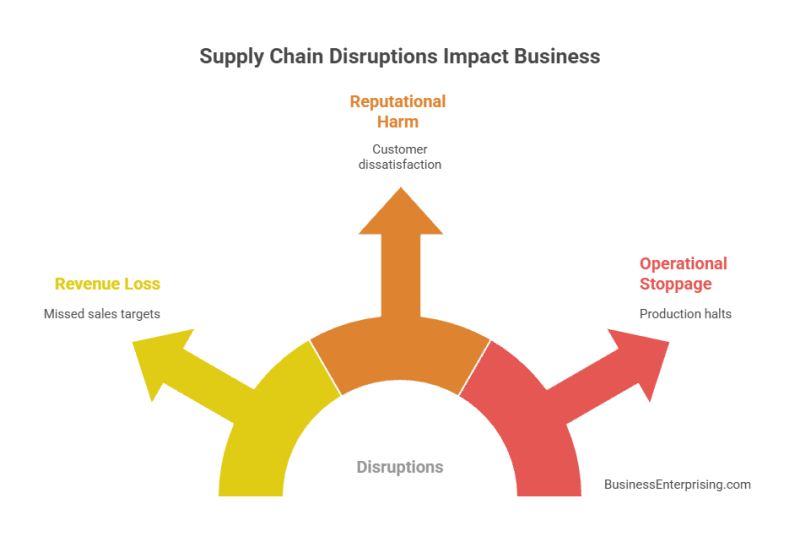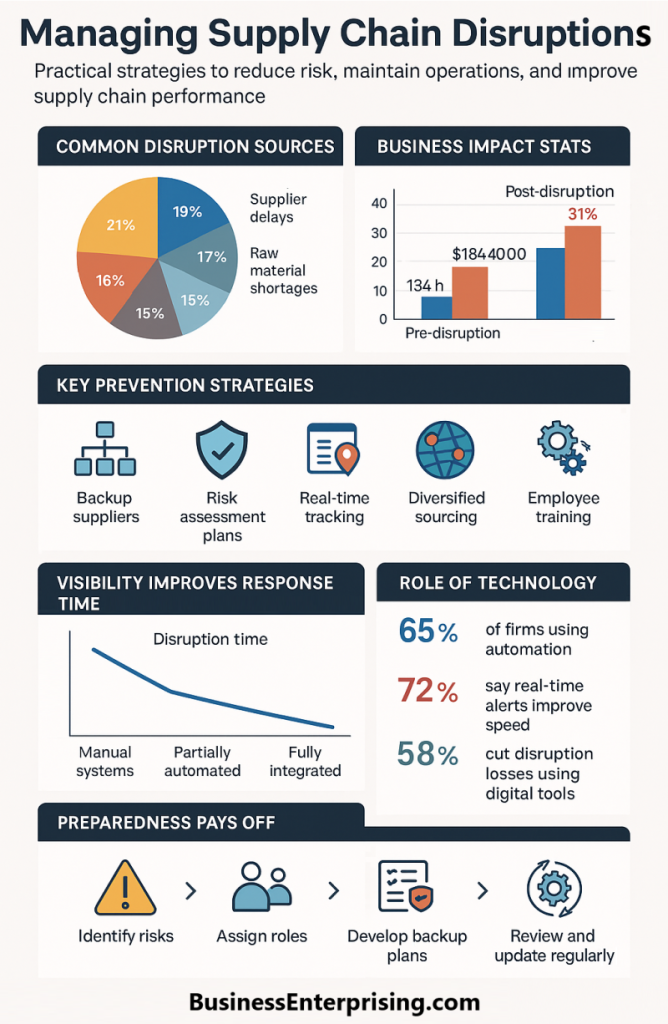 Managing supply chain disruptions has become a regular part of doing business. Delays, shortages, and unexpected breakdowns can affect every industry. However, with the right systems and habits, you can reduce their impact and protect your operations. Additionally, supply chain stability supports your reputation and customer relationships. When orders arrive on time, people trust your business. Therefore, building a flexible and responsive system should be part of your ongoing strategy.
Managing supply chain disruptions has become a regular part of doing business. Delays, shortages, and unexpected breakdowns can affect every industry. However, with the right systems and habits, you can reduce their impact and protect your operations. Additionally, supply chain stability supports your reputation and customer relationships. When orders arrive on time, people trust your business. Therefore, building a flexible and responsive system should be part of your ongoing strategy.
You don’t need to predict every problem. Instead, focus on how fast you can react and recover. That means reviewing your suppliers, systems, and planning habits. Additionally, involve your team so everyone understands how to respond when things go wrong. Technology also plays a role. From inventory tracking to real-time alerts, smart tools help you see problems before they grow. However, tools alone are not enough. You need clear plans and strong communication across all levels of your business.
Managing risk is an ongoing process. As your business grows, so do your supply chain needs. Therefore, regular reviews help you spot new gaps and fix them before they cost you time or money. A strong supply chain keeps your business running during uncertain times. That kind of strength comes from preparation, not reaction. With a few focused changes, you can build systems that keep moving even when others stall.
Understanding the Impact of Supply Chain Disruptions
Supply chain disruptions can affect nearly every part of your business. Delays in raw materials, inventory, or shipping often lead to lost revenue. Additionally, they can harm your reputation if customers face unexpected delays or cancellations. However, not all disruptions come from suppliers. Weather, labor shortages, or technology failures can stop your operations without warning. Therefore, it’s important to look beyond price when choosing your vendors or partners. You need reliability and responsiveness under pressure.
Managing supply chain disruptions requires preparation. Build backup plans and identify your most time-sensitive materials or services. Additionally, stay in regular contact with your suppliers. A quick response can limit the damage caused by delays. Transparency matters too. Keep your customers informed when problems arise. Most will stay patient if you communicate early and clearly. However, silence leads to frustration and lost trust. Therefore, your internal team must stay aligned and ready to respond.
You should also review your supply chain regularly. Changes in demand, costs, or transportation may introduce new risks. Additionally, consider sourcing some materials from multiple vendors to reduce exposure. Disruptions will happen, but they don’t have to cause long-term harm. With strong systems and clear priorities, you can respond faster and recover with less damage. Therefore, don’t wait for a problem to start preparing. A flexible and well-managed supply chain supports business growth. It also helps you keep your promises to customers and partners. That reliability builds long-term value and stronger business relationships.
Diversifying the Supplier Base
Relying on one supplier may seem efficient, but it increases your exposure to delays, shortages, or unexpected cost changes. One disruption can slow or stop production. Therefore, diversifying your supplier base helps reduce that risk and protect your business. Additionally, having multiple sources allows you to shift quickly when problems arise. If one vendor fails, another can help fill the gap. That flexibility makes your supply chain stronger and more stable during changing conditions.
However, working with more suppliers means more coordination. You need clear systems for tracking inventory, pricing, and lead times across all sources. Therefore, use tools that keep communication and documentation organized. Managing supply chain disruptions becomes easier when you have options. You can avoid production gaps, missed deadlines, and last-minute panic. Additionally, you may gain better pricing by comparing quotes from different sources over time.
Local and international suppliers each offer different strengths. Therefore, a mix of both can help you balance speed, cost, and reliability. Review your needs and select partners based on more than price. You should also test new suppliers before giving them large orders. That helps build trust and lets you spot problems early. Additionally, check their reliability, communication, and ability to scale with your demand. Supply chain diversity is a smart business habit. It adds work up front but saves time and money long term. Therefore, take small steps now to expand your base. You’ll be more resilient when problems come.
Implementing Risk Management Strategies
Every business faces supply chain risk. Whether it’s a late shipment, raw material shortage, or equipment failure, problems will happen. However, smart companies take action before disruptions occur. That’s where risk management strategies come into play.
Start by identifying your biggest supply chain risks. These may include supplier delays, weather events, or transportation breakdowns. Additionally, internal risks such as system failures or staffing shortages can also affect operations. Therefore, evaluate each area that could stop or slow your workflow. Once risks are identified, create response plans for each one. You want clear steps, responsibilities, and communication paths. Additionally, train your team to follow those plans so responses stay consistent and fast.
Managing supply chain disruptions is easier when you’re prepared. Delays may still happen, but their impact will be smaller. Therefore, don’t rely on guesswork when problems arise. Use real data and documented plans to stay ahead. Review your strategies often. As your business changes, so do your risks. Therefore, make time to update your assessments and action plans regularly. Small updates can prevent big losses down the road.
Technology can help reduce risk too. Use tools to track inventory, vendor performance, and delivery timelines. Additionally, stay connected with suppliers so you can react to changes before they escalate. No system is perfect. However, preparation gives you more control and faster recovery. Risk management doesn’t stop disruptions, but it limits their impact and protects your bottom line.
Enhancing Supply Chain Visibility
Supply chain visibility helps you see what’s happening across your entire operation. You can track delays, spot shortages, and solve problems faster. That kind of insight keeps your business moving, even when issues arise. Additionally, clear visibility supports better planning. When you know where products are and when they’ll arrive, you can set accurate timelines. That leads to stronger customer service and fewer last-minute surprises. Therefore, tracking each step of your supply chain is time well spent. However, visibility is not about more reports. It’s about having useful information in the right hands at the right time. Use tools that give real-time data without slowing your team down. Additionally, check that each system connects well with others.
Managing supply chain disruptions becomes easier when your data is current and accessible. You can respond before delays impact your schedule. Therefore, set up alerts and checkpoints so you’re never the last to know. You should also share visibility with key partners. When suppliers and carriers see the same data, everyone moves faster. Additionally, open communication builds trust and helps fix problems before they grow.
Keep reviewing your visibility tools and processes. As your supply chain changes, so should the way you track it. Ask your team what’s missing or what could be clearer. Small fixes now may prevent big headaches later. Better visibility means better decisions. That leads to fewer disruptions, tighter controls, and stronger results. With the right systems in place, your supply chain becomes a source of strength.
Developing Contingency Plans
No supply chain runs perfectly all the time. Delays, breakdowns, and shortages are part of doing business. However, the damage depends on how you respond. That’s why building strong contingency plans is a smart move for any operation. Additionally, plans should be specific, not vague. Think through what you would do if a key supplier shuts down or a delivery is late. Therefore, assign tasks, set timelines, and list backup options. Your team needs clear steps, not guesses, when things go wrong.
You also need to involve your vendors and partners. Ask how they handle problems and what support they offer during disruptions. Additionally, share your expectations so everyone stays aligned. Coordination helps you respond faster and with less confusion.
Managing supply chain disruptions becomes easier when you have a plan in place. You reduce panic and protect your output. Therefore, take time to test your plans under different scenarios. The more you prepare, the more confident your team becomes. However, building the plan is only the beginning. Review and update it every few months. Your business changes, and your plan should grow with it. Additionally, gather feedback from past events to improve your responses over time.
Good contingency plans reduce downtime, protect revenue, and build customer trust. They turn unexpected problems into manageable tasks. Therefore, make contingency planning part of your regular operations. It’s not about avoiding problems but being ready when they show up.
Building a Resilient Supply Chain
A resilient supply chain can absorb pressure and keep moving when things go wrong. It supports daily operations without constant worry or stress. However, resilience doesn’t happen by chance. It requires structure, planning, and regular attention. Additionally, strong supply chains are built on flexibility. That means working with more than one supplier and having clear backup options. Therefore, review your vendor mix and identify areas where a single point of failure exists.
You should also invest in clear communication. When teams, vendors, and carriers stay informed, decisions get made faster. Additionally, open dialogue builds trust during high-pressure moments. That kind of teamwork reduces delays and keeps orders on track. Technology plays a role too. Real-time tracking and automated alerts help you spot delays before they impact production. Therefore, use tools that help you respond quickly and accurately.
Managing supply chain disruptions gets easier when your system is designed to adapt. A resilient supply chain doesn’t break when something shifts. It bends and adjusts without losing speed. Additionally, that strength supports both customer trust and internal confidence. However, building resilience takes consistent effort. Review performance, test contingency plans, and make small improvements often. That steady focus helps you avoid large, expensive breakdowns later.
Resilience is not about predicting every problem. It’s about staying ready to act when things change. Therefore, treat your supply chain like a living system that needs regular care. With the right habits and support, you can build a supply chain that supports long-term business success.
Leveraging Technology and Innovation
Technology helps you move faster, track more, and react with better timing. That kind of precision makes supply chains stronger. However, it only works when used with purpose, not as a quick fix. Additionally, innovation supports smarter decisions. You can gather real-time data, monitor delivery points, and adjust orders with fewer delays. Therefore, use systems that connect your operations, vendors, and logistics. The more you know, the better you perform.
Managing supply chain disruptions becomes easier when technology alerts you early. A quick response limits the damage and keeps orders moving. Additionally, automation removes manual steps that slow you down or create risk. However, not all tools fit every business. Choose what supports your actual process, not what sounds impressive. Start small and expand based on results. Your team should find the tools helpful, not confusing.
Innovation also means looking at how you work. Review your systems, vendors, and reporting methods. Additionally, ask what slows you down or causes errors. New tools can remove those blocks and improve your performance over time.
You don’t need a complete overhaul to benefit. Many gains come from minor adjustments and better visibility. Therefore, track results and measure what changes help most. Technology supports resilience and speed. It also helps you prevent delays, improve service, and lower costs. With the right tools in place, your supply chain becomes smarter and stronger.
Conclusion
Supply chain problems will happen, but how you prepare makes all the difference. A reactive approach leads to stress and missed goals. However, a steady plan with clear systems gives you more control and fewer surprises. Additionally, flexibility strengthens your response. A diverse supplier base, reliable data, and trained teams help reduce pressure during high-risk moments. Therefore, review each part of your operation and look for ways to improve speed, accuracy, and coordination.
Managing supply chain disruptions requires more than luck. It depends on the habits, tools, and relationships you build ahead of time. Therefore, track what works and refine what doesn’t. Small fixes now can protect you from larger problems later.
Technology helps, but only when used with clear purpose. Use tools that support your goals and connect your supply chain. Additionally, set up alerts, track key data, and check vendor performance regularly. That information helps you respond quickly and confidently.
Your team also plays a role. Train them to act, communicate, and adapt under pressure. When everyone understands the plan, disruptions become easier to manage. Therefore, make planning and communication part of your routine, not a one-time task. Supply chains move fast. The stronger your foundation, the better your results. Build systems that flex without breaking. With the right structure in place, you can protect your service, revenue, and reputation under pressure.


